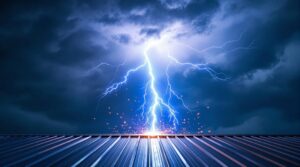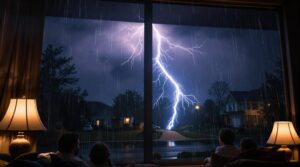When a house is struck by lightning, the electrical discharge can travel through various conductive paths, potentially harming occupants. The risk of electrical shock increases during storms, especially when using landline phones or coming into contact with metal plumbing and electrical wiring. While being indoors offers some protection, it is not a guarantee of safety. Understanding the risks and taking necessary precautions can help minimize harm, and exploring the subject further can provide valuable insights into safeguarding against lightning strikes. It is essential to recognize that while lightning can indeed strike your home, there are ways to enhance its protection. Installing lightning rods and surge protectors can significantly diminish the risk of damage and electrical injuries. By staying informed about weather conditions and understanding how to respond during a storm, homeowners can take proactive steps to answer the question, “can lightning strike your home” and ensure their safety and that of their loved ones.
Key Takeaways
- A house being struck by lightning doesn't necessarily mean occupants will be harmed or killed if proper safety precautions are taken.
- The risk of injury or death increases if occupants are in contact with electrical wiring, plumbing, or metal objects during a strike.
- The safest place in a home during a lightning storm is typically the center, away from windows, doors, and metal objects.
- Installing a lightning protection system can help direct lightning safely into the ground, reducing the risk of injury or damage.
- Taking proactive measures, such as unplugging electronics and avoiding landline phones, can also minimize the risk of injury or damage during a lightning strike.
Understanding the Risks of Indoor Lightning Strikes
How does lightning pose a threat to individuals indoors? When a storm approaches, it is essential to go indoors to minimize the risk of being struck by lightning. However, indoor lightning strikes can still occur, posing a significant threat to individuals. Electrical wiring, plumbing, and electronic devices can conduct electricity from lightning strikes, putting people at risk of electrical shock.
To mitigate this risk, it is recommended to unplug electronic devices and appliances during a storm. This can help prevent damage from power surges caused by lightning strikes. Additionally, individuals should avoid contact with metal plumbing and electrical wiring, as these can impart electrical charges. By understanding the risks of indoor lightning strikes and taking necessary precautions, individuals can reduce their risk of injury or harm. Staying informed and taking proactive steps can help create a safer environment during storms.
How Lightning Enters a Home
Numerous pathways allow lightning to enter a home, posing a significant threat to the safety of its occupants. When lightning struck, it can travel through various systems and structures, putting individuals at risk. Understanding these pathways is essential for maintaining safety during storms.
There are several ways in which lightning enters a home:
- Through electrical systems: Lighting can cause electrical surges that damage appliances and electronics, despite the presence of Surge Protectors.
- Via plumbing: Metal plumbing systems are particularly susceptible to electrical charge transfer during a lightning strike.
- Over telephone lines: Using landline phones during storms is hazardous, as lightning can travel through the phone lines.
- Through wireless devices: Although less common, lightning can interfere with wireless devices, posing a risk to users.
Safety Precautions to Minimize Risk
Generally, individuals can minimize the risk of injury or death from lightning strikes by taking certain safety precautions. Staying informed about storm forecasts allows for timely action to be taken. Knowing the safest place in a home is vital, typically in the center, away from windows, and metal objects. Avoid using landline phones, opt for a cell phone instead. In addition, avoid using bathtubs or showers during storms as lightning can impart electrical charges to metal plumbing systems, posing a danger.
Unplugging electronic devices before a storm can prevent damage from power surges caused by nearby lightning strikes. This simple action protects valuable equipment in the event a house is struck by lightning. Moreover, exercising caution with wireless devices near windows is essential. Ultimately, adhering to these safety guidelines reduces the risk of injury from lightning strikes. Implementing these habits promises to prepare individuals and households for potential storms.
Preparing for and Responding to Lightning Strikes
When a house is struck by lightning, what is the most effective course of action to guarantee the occupants' safety? To prepare for and respond to lightning strikes, it is essential to take proactive measures. Inside your home, staying informed about the lightning storm and its severity is important.
The following steps can help minimize risks:
- Unplug electronics and appliances: During a lightning storm, unplug sensitive electronics and appliances to prevent damage from power surges.
- Avoid using landline phones and plumbing fixtures: Refrain from using landline phones and plumbing fixtures, as lightning can travel through phone lines and metal pipes.
- Stay away from windows and metal objects: Keep a safe distance from windows, metal objects, and electrical wiring to prevent injury.
- Install a lightning protection system: Consider installing a lightning protection system to direct the power of lightning safely into the ground.








